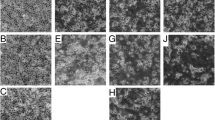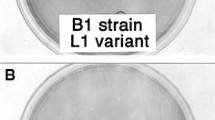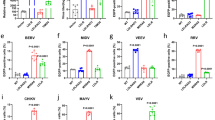Summary
Herein, it is shown for the first time that the mechanism of fusion followed in Aedes albopictus cells infected with Semliki Forest virus induced by low pH exposure is a “fusion from within”. Several parameters were studied disclosing that the development of the fusion capacity of the cells is directly related to the synthesis of viral specific products. These findings were further substantiated by utilizing various chemicals to inhibit viral specific events during infection, protein synthesis and maturation. Removal of exogenous virions produced at 16 hours post infection by proteinase K digestion clearly revealed that the viral proteins located at the cell surface and not the exogenous virions were responsible for the fusogenic activity. The presence of these viral proteins at the cell surface was disclosed by immunofluorescence employing anti-SFV antibodies elicited in rabbits. Additional evidence for the participation of the viral proteins at the cell surface in the fusion reaction was obtained by Bromelaine digestion which inhibited the fusion and tunicamycin treatment which only partially inhibited the fusion but revealed the inevitable presence of the E1 protein.
Similar content being viewed by others
References
Ahkong, Q. F., Botham, G. M., Woodward, A. W., Lucy, J. A.: Calcium-activated thiol-proteinase activity in the fusion of rat erythrocytes induced by benzyl alcohol. Biochem. J.192, 829–836 (1980).
Boss, W. F., Morré, D. J., Mollenhauer, H. H.: Monensin-induced swelling of Golgi apparatus cisternae mediated by a proton gradient. Eur. J. Cell Biol.34, 1–8 (1984).
Bratt, M. A., Gallaher, W. R.: Preliminary analysis of the requirements for fusion from within and fusion from without by Newcastle disease virus. Proc. Natl. Acad. Sci. U.S.A.64, 536–543 (1969).
Butters, T. D., Hughes, R. C.: Isolation and characterization of mosquito cell membrane glycoproteins. Biochim. Biophys. Acta640, 655–671 (1981).
Cassell, S., Edwards, J., Brown, D. T.: Effects of lysosomotropic weak bases on infection of BHK-21 cells by Sindbis virus. J. Virol.52, 857–864 (1984).
Chamberlain, J. P.: Fluorographic detection of radioactivity in polyacrylamide gels with the water soluble fluor, sodium salicylate. Anal. Biochem.98, 132–135 (1979).
Den, H.: Effect of monensin on myoblast fusion. Biochem. Biophys. Res. Commun.126, 313–319 (1985).
Eaton, B. T., Faulkner, P.: Heterogeneity in the poly (A) content of the genome of Sindbis virus. Virology50, 865–873 (1972).
Eaton, B. T., Regnery, R. L.: Polysomal RNA in Semliki Forest virus infected Aedes albopictus cells. J. gen. Virol.29, 35–49 (1975).
Edwards, J., Brown, D. T.: Sindbis virus induced fusion of tissue cultured Aedes albopictus (mosquito) cells. Virus Res1, 705–711 (1984).
Edwards, J., Mann, E., Brown, D. T.: Conformational changes in Sindbis virus envelope proteins accompanying exposure to low pH. J. Virol.45, 1090–1097 (1983).
Gallaher, W. R., Levitan, D. B., Kirwin, K. S., Blough, H. A.: Molecular and Biological Parameters of Membrane Fusion. In:Blough, H. A., Tiffany, J. M. (eds.), Cell Membranes and Viral Envelopes. Vol. 1, 395–457. New York: Academic Press 1980.
Garoff, H., Kondor-Koch, Cl., Riedel, H.: Structure and assembly of alpha viruses. Curr. Top. Microbiol. and Immunol.99, 1–50 (1982).
Gates, D., Brown, A., Wust, C. J.: Comparison of specific and cross-reactive antigens of alpha-viruses on virions and infected cells. Infection and Immunity35, 248–255 (1982).
Gliedman, J. B., Smith, J. F., Brown, D. T.: Morphogenesis of Sindbis virus in cultured Aedes albopictus cells. J. Virol.16, 913–926 (1975).
Helenius, A., Kielian, M., Wellsteed, J., Mellman, I., Rudnick, G.: Effects of monovalent cations on Semliki Forest virus entry into BHK-21 cells. J. Biol. Chem.260, 5691–5697 (1985).
Helenius, A., Marsh, M., White, J.: Inhibition of Semliki Forest virus penetration by lysosomotropic weak bases. J. gen. Virol.58, 47–61 (1982).
Hsieh, P., Robbins, P. W.: Regulation of asparagine-linked oligosaccharide processing. Oligosaccharide processing in Aedes albopictus mosquito cells. J. Biol. Chem.259, 2375–2382 (1984).
Hsu, M. C., Scheid, A., Choppin, P. W.: Fusion of Sendai virus with liposomes: dependence on the viral fusion protein (F) and the lipid composition of liposomes. Virology126, 361–369 (1983).
Igarashi, A.: Isolation of a Singh's Aedes albopictus cell clone sensitive to Dengue and Chikungunya viruses. J. gen. Virol.40, 531–544 (1978).
Kääriäinen, L., Hashimoto, K., Saraste, J., Virtanen, I., Penttinen, K.: Monensin and FCCP inhibit the intracellular transport of alphavirus membrane glycoproteins. J. Cell Biol.87, 783–791 (1980).
Kielian, M. C., Helenius, A.: Role of cholesterol in fusion of Semliki Forest virus with membranes. J. Virol.52, 281–283 (1984).
Klenk, H. D., Schwarz, R. T.: Viral glycoprotein metabolism as a target for antiviral substances. Antiviral Res.2, 177–190 (1982).
Koblet, H., Kempf, C., Kohler, U., Omar, A.: Conformational changes at pH 6 on the cell surface of Semliki Forest virus infected Aedes albopictus cells. Virology143, 334–336 (1985).
Koblet, H., Omar, A., Kempf, C.: Fusion of Alphavirus infected mosquito cells. In:Yunker, C. E. (ed.), Arbovirus Cultivation in Arthropod Cellsin vitro. Boca Raton, Fla.: CRC Press, in press.
Kondor-Koch, C., Burke, B., Garoff, H.: Expression of Semliki Forest virus proteins from cloned complementary DNA. I. The fusion activity of the spike glycoprotein. J. Cell Biol.97, 644–651 (1983).
Kondor-Koch, C., Garoff, H.: Construction of a hybrid plasmid molecule containing the total coding region of Semliki Forest virus 26S mRNA. J. gen. Virol.58, 443–448 (1982).
Kondor-Koch, C., Riedel, H., Soderberg, K., Garoff, H.: Expression of the structural proteins of Semliki Forest virus from cloned cDNA microinjected into the nucleus of baby hamster kidney cells. Proc. Natl. Acad. Sci. U.S.A.79, 4525–4529 (1982).
Laemmli, U. K.: Cleavage of structural proteins during the assembly of the head of bacteriophage T4. Nature (London)227, 680–685 (1970).
Mann, E., Edwards, J., Brown, D. T.: Polycaryocyte formation mediated by Sindbis virus glycoproteins. J. Virol.45, 1083–1089 (1983).
Marsh, M., Helenius, A.: Adsorptive endocytosis of Semliki Forest virus. J. Mol. Biol.142, 439–454 (1980).
McMaster, G. K., Carmichael, G. G.: Analysis of single- and double-stranded nucleic acids on polyacrylamide and agarose gels by using glyoxal and acridine orange. Proc. Natl. Acad. Sci. U.S.A.74, 4835–4838 (1977).
Pressman, B. C.: Biological applications of ionophores. Ann. Rev. Biochem.45, 501–530 (1976).
Richardson, M. A., Boulton, R. W., Raghow, R. S., Dalgarno, L.: Polypeptide synthesis in alphavirus-infected Aedes albopictus cells during the establishment of persistent infection. Arch. Virol.64, 263–274 (1980).
Sarver, N., Stollar, V.: Sindbis virus-induced cytopathic effect in clones of Aedes albopictus (Singh) cells. Virology80, 390–400 (1977).
Schilt, U.: Differentiation of Herpes simplex virus type 1 and type 2 by immunofluorescence: discriminative staining by labelled IgG preparations. Z. Immun-Forsch.155, 411–419 (1979).
Schwarz, R. T., Datema, R.: Inhibitors of protein glycosylation. Trends in Biochem. Sci.1980, 65–67.
Simizu, B., Maeda, S.: Growth patterns of temperature-sensitive mutants of Western Equine Encephalitis virus in cultured Aedes albopictus (mosquito) cells. J. gen. Virol.56, 349–361 (1981).
Spaeth, P. J., Koblet, H.: Alphavirus Induced Syncytium Formation in Aedes albopictus Cell Cultures. In:Kurstak, E., Maramorosch, K., Duebendorfer, A. (eds.), Invertebrate Systemsin vitro, 375–388. Amsterdam: Elsevier/North-Holland Biomedical Press 1980.
Stalder, J., Reigel, F., Koblet, H.: Defective viral RNAs in Aedes albopictus C6/36 cells persistently infected with Semliki Forest virus. Virology129, 247–254 (1983).
Stollar, V.: Togaviruses in Cultured Arthropod Cells. In:Schlesinger, R. W. (ed.), The Togaviruses: Biology, Structure, Replication, 583–621. New York: Academic Press 1980.
Sweet, B. H., Unthank, H. D.: A comparative study of the viral susceptibility of monolayer and suspended mosquito cell lines. Curr. Top. Microbiol. Immunol.55, 150–154 (1971).
Thomas, P. S.: Hybridization of denatured RNA and small DNA fragments transferred to nitrocellulose. Proc. Natl. Acad. Sci. U.S.A.77, 5201–5205 (1980).
Väänänen, P., Gahmberg, C. G., Kääriäinen, L.: Fusion of Semliki Forest virus with red cell membranes. Virology110, 366–374 (1981).
Väänänen, P., Kääriäinen, L.: Fusion and haemolysis of erythrocytes caused by three togaviruses: Semliki Forest, Sindbis and Rubella. J. gen. Virol.46, 476–475 (1980).
Weintraub, H., Palter, K., van Lente, F.: Histones H2a, H2b, H3 and H4 form a tetrameric complex in solution of high salt. Cell6, 85–110 (1975).
White, J., Helenius, A.: pH-dependent fusion between the Semliki Forest virus membrane and liposomes. Proc. Natl. Acad. Sci. U.S.A.77, 3273–3277 (1980).
White, J., Kartenbeck, J., Helenius, A.: Fusion of Semliki Forest virus with the plasma membrane can be induced by low pH. J. Cell Biol.87, 264–272 (1980).
White, J., Matlin, K., Helenius, A.: Cell fusion by Semliki Forest, Influenza, and vesicular stomatitis viruses. J. Cell Biol.89, 674–679 (1981).
Wilcox, G. E., Compans, R. W.: Cell fusion induced by Nelson Bay virus. Virology123, 312–322 (1982).
Wolcott, J. A., Wust, C. J., Brown, A.: Identification of immunologically cross-reactive proteins of Sindbis virus: evidence for unique conformation of E1 glycoprotein from infected cells. J. Virol.49, 379–385 (1984).
Yunker, C. E., Cory, J.: Plaque production by Arboviruses in Singh's Aedes albopictus cells. Appl. Microbiol.29, 81–89 (1975).
Author information
Authors and Affiliations
Additional information
With 2 Figures
Rights and permissions
About this article
Cite this article
Omar, A., Flaviano, A., Kohler, U. et al. Fusion of Semliki Forest virus infected aedes albopictus cells at low pH is a fusion from within. Archives of Virology 89, 145–159 (1986). https://doi.org/10.1007/BF01309885
Received:
Accepted:
Issue Date:
DOI: https://doi.org/10.1007/BF01309885




